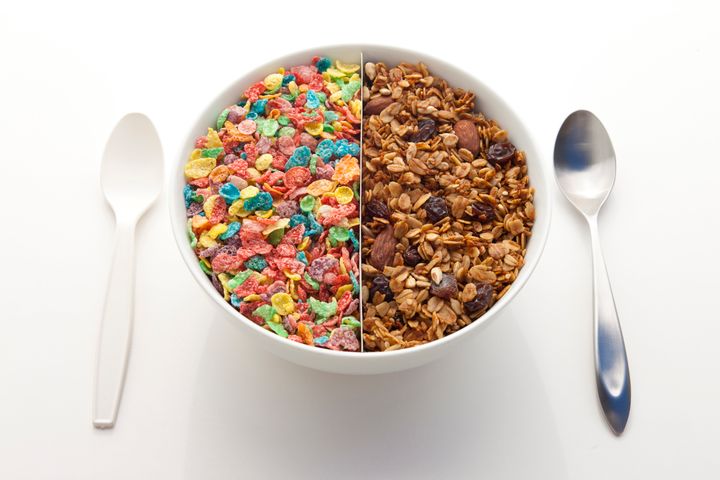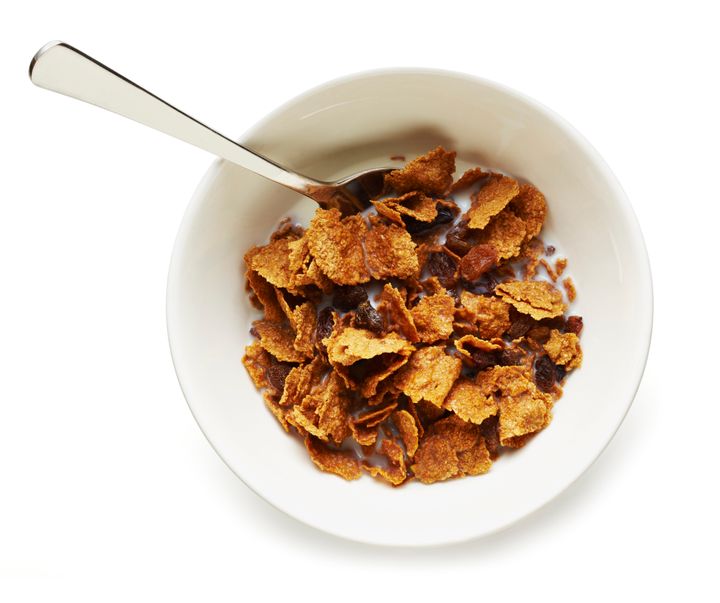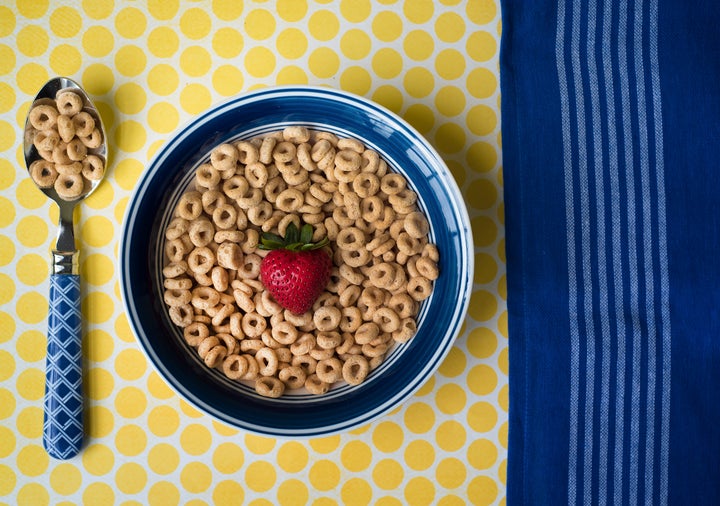
Although debate continues on whether breakfast is the most important meal of the day, breakfast cereal sales keep growing year after year, with $15 billion in revenue expected in 2018.
Though cereal is certainly appealing for its quick and easy preparation, sorting through the multitudes of options at grocery aisles can be a tricky task if you’re looking for something healthy. It’s a good rule of thumb to steer clear of artificially colored cereals with cartoon characters on the box, but other seemingly nutritious brands tout misleading claims of wholesome ingredients and other health benefits, concealing some not-so-great qualities, such as excessive added sugar.
We chatted with two nutritionists to get some clarity on what makes for a healthy cereal, and asked them to rank the nation’s most popular varieties.
Here are America’s nine top-selling cereals, according to 2017 figures from Chicago-based data firm IRI:
- Honey Nut Cheerios
- Honey Bunches of Oats
- Frosted Flakes
- Cinnamon Toast Crunch
- Cheerios
- Froot Loops
- Frosted Mini-Wheats
- Lucky Charms
- Raisin Bran
Here’s what our nutritionists look for in a healthy cereal
“I like to recommend shopping for whole grain options,” Amy Gorin, owner of Amy Gorin Nutrition in New York, told HuffPost. “You can take a look at the ingredients list of the cereal to check that the first ingredient is a whole grain. That ingredient might be whole wheat, oats, cornmeal or another whole grain.”
Gorin added that ample fiber (at least 3 grams per serving), some protein (at least 5 grams per serving) and a conservative amount of sugar (no more than 4-6 grams per serving) is also ideal. “Protein and fiber help keep you fuller for longer, and we should try and limit our intake of added sugar,” she said.
Jonathan Valdez, owner of Genki Nutrition and media rep for the New York State Academy of Nutrition and Dietetics, recommended checking out the total carbohydrates as well, ideally 45-60 grams per meal, to make sure you have enough energy to power through the morning.
Here’s what they try to avoid
When it comes to added sugar, less is better, and when possible opt for fruit to add sweetness rather than table sugar, Valdez said.
Unlike whole grains, refined grains like white flour and degerminated cornmeal have been stripped of most of their fiber, vitamins and minerals. They are more quickly digested and have a high glycemic index, which may lead to overeating.
Those with high blood pressure or a family history of this condition should also take note of the amount of sodium in cereal, Valdez said. Aim for less than 5 percent of the daily value.
When looking at a nutrition label, it’s important to note the serving size, which can vary widely from cereal to cereal. Remember that the size of your favorite bowl does not a serving make. Ready-to-eat cereals range from 3/4 to 1 1/2 cups and granolas are usually around 1/3 cup.
The first ranking
Below is Valdez’s ranking of these cereals from healthiest to least healthy, with key nutrition facts for reference.
“In general when choosing cereals, I always look at the protein and fiber content more than anything,” says Valdez. “These are the components that will help you stay fuller for longer. If you have a low-calorie breakfast, you will likely have cravings later... and are more likely to eat more.”
Of his top pick, Raisin Bran, Valdez said, “The added sugar is coming from the raisins, versus table sugar. Raisins are grapes and they contains antioxidants.” Froot Loops and Frosted Flakes, the refined grain options of the bunch, are ranked lowest.

1. Raisin Bran (high fiber, high sugar)
- Whole grain? Yes
- Serving size: 1 cup (59 g)
- Fiber: 7g
- Sugar: 18g (9g added sugar)
- Protein: 5g
2. Cheerios (good fiber, low sugar)
- Whole grain? Yes
- Serving size: 1 cup (28g)
- Fiber: 3g
- Sugar: 1g
- Protein: 3g
3. Honey Bunches of Oats (low fiber, low sugar)
- Whole grain? Yes
- Serving size: 3/4 cup (32g)
- Fiber: 2g
- Sugar: 6g
- Protein: 2g
4. Frosted Mini-Wheats (high fiber, high sugar)
- Whole grain? Yes
- Serving size: 21 biscuits (54 g)
- Fiber: 6g
- Sugar: 11g
- Protein: 5g
5. Honey Nut Cheerios (low fiber, high sugar)
- Whole grain? Yes
- Serving size: 3/4 cup (28g)
- Fiber: 2g
- Sugar: 9g
- Protein: 2g
6. Cinnamon Toast Crunch (low fiber, high sugar)
- Whole grain? Yes
- Serving size: 3/4 cup (31 g)
- Fiber: 2g
- Sugar: 9g
- Protein: 1g
7. Lucky Charms (low fiber, high sugar)
- Whole grain? Yes
- Serving size: 3/4 cup (27 g)
- Fiber: 2g
- Sugar: 10g
- Protein: 2g
8. Froot Loops (not whole grain, good fiber, high sugar)
- Whole grain? Partially (the first ingredient is a corn flour blend containing whole grain corn flour and degerminated yellow corn flour)
- Serving size: 1 cup (29 g)
- Fiber: 3g
- Sugar: 10g
- Protein: 2g
9. Frosted Flakes (not whole grain, very little fiber, high sugar)
- Whole grain? No (first ingredient is milled corn)
- Serving size: 3/4 cup (29 g)
- Fiber: <1g
- Sugar: 10g
- Protein: 1g
The second ranking
Gorin’s ranking, though similar, has a few key differences.
“Out of these, Cheerios would be my first choice because they have a base of whole grains and are low in sugar,” she said.
She listed Honey Bunches of Oats above Raisin Bran despite the latter’s higher fiber and protein content. “I’d rather see a cereal have slightly less fiber and protein and less added sugar. [Honey Bunches of Oats] also has more healthy poly- and monounsaturated fats.”
Frosted Mini-Wheats lands below Honey Nut Cheerios, Cinnamon Toast Crunch and Lucky Charms on Gorin’s list, losing points for its high sugar content. While Raisin Bran has naturally occurring sugars from dried fruit, the second and third ingredients of Frosted Mini-Wheats ― after whole grain wheat ― are sugar and brown rice syrup, aka added sugar. “You can always add forms of fiber and protein to your cereal (i.e. berries and nuts), but you can’t take away the added sugar,” Gorin said.

1. Cheerios
2. Honey Bunches of Oats
3. Raisin Bran
4. Honey Nut Cheerios
5. Cinnamon Toast Crunch
6. Lucky Charms
7. Frosted Mini-Wheats
8. Froot Loops
9. Frosted Flakes
Other nutritionist-approved cereals
Valdez’s short list includes Special K Protein Cereal, featuring 10 grams of protein per 3/4 cup serving, relatively low sugar (7 grams) and adequate fiber (3 grams). Kashi 7 Whole Grain Flakes Cereal is also on the list, with 6 grams of protein per 1-cup serving, low sugar (6 grams) and high fiber (6 grams). Lastly, Kashi 7 Whole Grain Puffs Cereal has 5 grams of protein per 1 1/2 cup serving, no sugar or sodium and a good amount of fiber (4 grams).
Gorin’s favorite options also include Kashi 7 Whole Grain Puffs Cereal, plus Kind Healthy Grains Dark Chocolate Whole Grain Clusters. “A lot of granolas are higher in calories, saturated fat or sugar,” Gorin said. “This option is just 110 calories per 1/3 cup serving and is a good source of filling protein… It’s also lower in added sugar. It has a base of five different whole grains, with oats as the first ingredient.”
“At the end of the day, don’t feel guilty if you have Frosted Flakes in the morning,” Valdez said. “The meal doesn’t matter as much as the collective diet. Now if you were to eat Frosted Flakes all day, that’s a different story.”
No matter which cereal you choose, he recommended complementing it with a few additions to round out your breakfast and reach a target 25-30 grams of protein per meal. This can be achieved by adding a cup of lowfat milk and fruit to cereal, plus three eggs with spinach or other mixed vegetables and garlic (which add fiber and antioxidants).